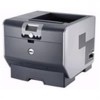Dell 5210n User's Guide - Page 141
Installing the Printer on the Network, Installing a Network Printer on Additional Network Computers - default username
 |
View all Dell 5210n manuals
Add to My Manuals
Save this manual to your list of manuals |
Page 141 highlights
b. Confirm the password. c. Click Install CA Certificate. d. Enter the path to the correct CA certificate, or click Browse to select the certificate. Click OK to install the certificate, or click Cancel to cancel the action. e. Click OK to return to the Advanced Mode home screen, and continue with step 6 of the advanced mode instructions. l If EAP-TLS is selected as the authentication mechanism: a. Enter an appropriate username for the 802.1x - RADIUS authentication server. b. Click Install Signed Certificate. c. Enter the path to the correct signed certificate, or click Browse to select the certificate. Click OK to install the certificate, or click Cancel to cancel the action. d. Click Install CA Certificate. e. Enter the path to the correct CA certificate, or click Browse to select the certificate. Click OK to install the certificate, or click Cancel to cancel the action. f. Click OK to return to the Advanced Mode home screen, and continue with step 6 of the advanced mode instructions. l If EAP-TTLS is selected as the authentication mechanism: a. Select the appropriate Inner Authentication to be used in conjunction with EAP-TTLS. b. Enter an appropriate username and password for the 802.1x - RADIUS authentication server. c. Confirm the password. d. Click Install CA Certificate. e. Enter the path to the correct CA certificate, or click Browse to select the certificate. Click OK to install the certificate, or click Cancel to exit the certificate dialog. f. Click OK to return to the Advanced Mode home screen, and continue with step 6 of the advanced mode instructions. Configuring WEP Encryption 1. Enter the appropriate WEP key(s). WEP encryption requires at least one WEP key, but can include up to four. 2. Select the default WEP transmit key. 3. Click OK to return to the Advanced Mode home screen, and proceed to step 7 of the advanced mode instructions. Configuring WPA Personal Encryption 1. Enter the appropriate Pre-Shared key. 2. Click OK to return to the Advanced Mode home screen, and proceed to step 7 of the advanced mode instructions. Creating a Certificate Request Some authentication mechanisms require certificates to work properly. In situations in which a signed certificate is required, a certificate request must be initiated in order to create a new signed certificate. To create a certificate request 1. Go to Certificates® Create Certificate Request. 2. Enter the appropriate certificate information. 3. Click Browse to navigate to the location where the certificate is to be saved. 4. Click OK to return to the Advanced Mode home screen, and proceed to step 6 of the advanced mode instructions. Installing the Printer on the Network Once the print server has been configured, the Wireless Setup Utility will return to the initial Drivers and Utilities CD screen. Click Network Installation - Install the printer for use on a network. For more information, see Installing Drivers for Network Printing. Installing a Network Printer on Additional Network Computers If you are installing the network printer for use with multiple computers on the network, repeat the Installing the Printer on the Network process for each computer that will have access to the printer. The wireless print server does not need to be reconfigured for each successive installation. Changing the Wireless Print Server Settings















